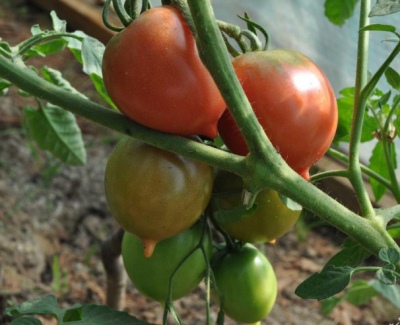
- Authors: Gavrish S.F., Morev V.V., Amcheslavskaya E.V., Degovtsova T.V., Volok O.A., Vasilyeva M.Yu., LLC breeding firm "Gavrish"
- Year of approval: 2015
- Category: grade
- Growth type: indeterminate
- Appointment: fresh consumption
- Ripening period: mid-early
- Ripening time, days: 110-120
- Growing conditions: for film greenhouses
- Bush size: tall
- Leaves: medium, green
Monisto pink is a tomato variety bred by Russian specialists, approved for use in 2015. Despite the relative novelty, the variety quickly won the hearts of gardeners. Let's take a closer look at this variety of tomatoes.
Description of the variety
The bush is tall, indeterminate type, reaches a length of 180-200 cm. The branchiness is weak, the foliage is medium. Leaves are medium in size, dark green in color, slightly rough.
The main qualities of the fruit
The unripe fruit is light green in color with a green spot, while the ripe fruit is pink in color. Tomatoes are small, weighing only 35-40 g, round in shape. They have good transportability due to their dense skin. The shelf life is about three weeks.
Taste characteristics
The taste of the fruit is rich, sweet, the aroma of traditional tomatoes. Some consumers experience fruity notes. The pulp is of medium density, contains 2-3 chambers with an average number of seeds. Basically, the fruits of Monisto pink are consumed fresh, the taste is especially pronounced in the salad. Canning of vegetables is also allowed.
Ripening and fruiting
The presented variety belongs to varieties with a medium early ripening period, harvesting falls on 110-120 days after the appearance of the first shoots.
Yield
Monisto pink has a high yield, productivity is 8.6-9.3 kg / sq. m.
The timing of planting seedlings and planting in the ground
Sowing is done in March. If grains from your own vegetables will be used for planting, then you need to sort them out, removing darkened and damaged samples. A nutritious but light substrate is suitable for sowing. You can cook it yourself by mixing peat, humus, black soil and sand in equal proportions. If the level of acidity in the ground is high, then it is recommended to introduce ash - tomatoes do not like acidic soil.
It is allowed to grow seedlings in peat tablets. This is quite simple to do.
Soak the tablets in boiling water to make them swell. Change the water if necessary.
After swelling, remove the material, turn it upside down and leave in this position until the liquid drains.
Dip one seed per 1 cm into each bag using a toothpick.
Put the tablets with the planting material in one container, cover with foil and remove to a warm place.
If the seeds are grown without tablets, then the sowing is done in one box filled with soil. Before planting, the soil is well watered. The seeds are buried 1 cm, the distance between two future seedlings should not be less than 2 cm. Next, the container is covered with a film and removed to a warm place where the temperature is maintained at + 23 ... 26 degrees. Seedling care is as follows.
When the first shoots appear, remove the film and leave the box in a well-lit place.
Water with a syringe or pipette, as water should not get on young shoots. The use of a watering can with a narrow spout is allowed.
When 2-3 leaves hatch, dive the seedlings. Do not forget to place a drainage layer on the bottom of each container.
At this stage, feeding begins. The first fertilization is applied after 10-14 days, the next two supplements are offered at intervals of 2-3 weeks.The last, fourth dressing is added three days before planting on the site.
Start hardening seedlings a couple of weeks before transplanting. Take the pots outside every day, gradually increasing the time you are outdoors.
The transplant is carried out in May.

Growing tomato seedlings is an extremely important process, because it largely depends on whether the gardener will be able to harvest at all. All aspects must be taken into account, from seedbed preparation to planting in the ground.
Landing scheme
The bushes are planted according to the scheme of 4 copies per 1 m2. The transplant is carried out in a film greenhouse.

Growing and care
Monisto Rose requires standard care, which includes pinching, garter and shaping. Forming is recommended to be carried out in one stem.




A plant needs different micronutrients at each stage of growth. All fertilizers can be divided into two groups: mineral and organic. Folk remedies are often used: iodine, yeast, bird droppings, eggshells.
It is important to observe the rate and period of feeding. This also applies to folk remedies and organic fertilizers.
Disease and pest resistance
The presented variety has a high immunity to the most common "tomato" ailments, including late blight.



























































































